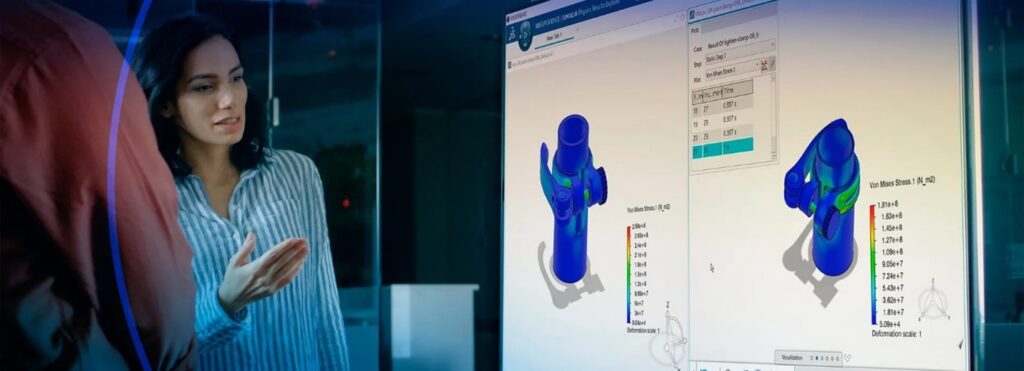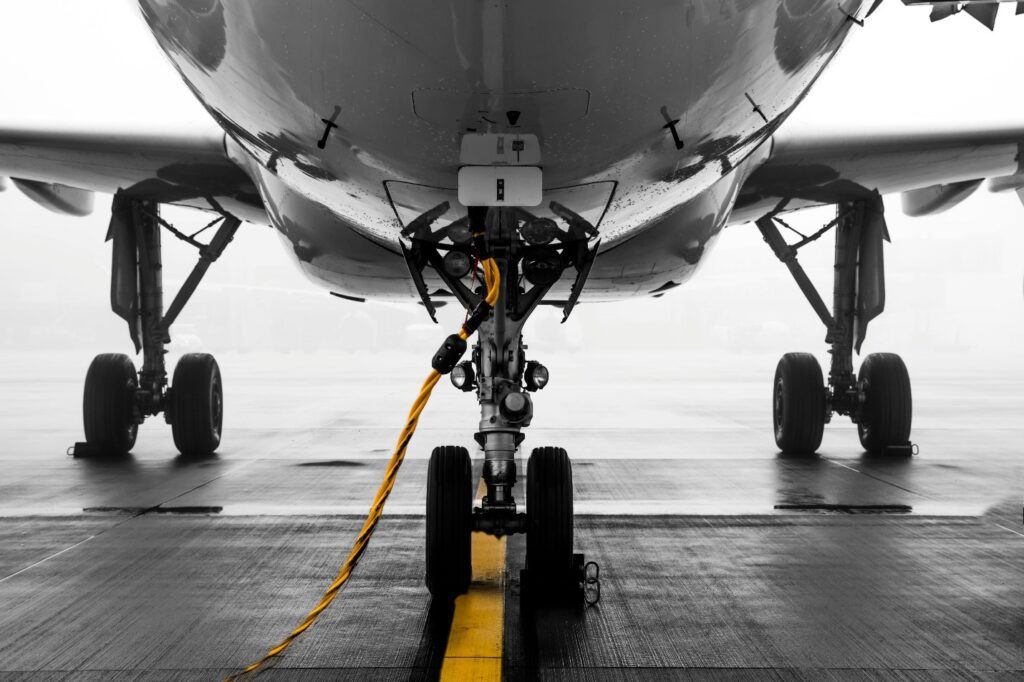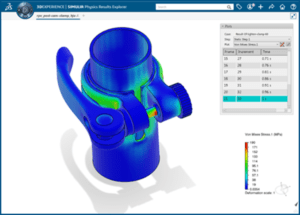Abstract
Aerospace engineering demands unmatched precision, safety, and efficiency in every component, from fuselage panels to turbine blades to passenger seats. Every structure in an aircraft is subjected to extreme forces, including aerodynamic pressure, thermal expansion, and mechanical stress. Identifying potential failure points, optimizing material usage, and validating designs before production are critical to ensuring aircraft longevity and passenger safety.
This is where SIMULIA’s structural simulation solutions play a pivotal role. Leveraging advanced finite element analysis (FEA), multiphysics simulation, and high-fidelity virtual stress testing, SIMULIA enables aerospace manufacturers to predict real-world performance with precision. By integrating these simulations early in the design phase, engineers can improve durability, streamline development cycles, and significantly reduce reliance on costly physical prototypes. SIMULIA even helps ensure compliance with stringent aviation regulations, like those set by the FAA and EASA, allowing manufacturers to confidently bring safer, more efficient aircraft to market.
This article explores how structural simulation with SIMULIA helps aerospace engineers optimize component design, enhance material efficiency, and increase safety across the industry.
Why Structural Simulation is Essential in Aerospace Engineering
Every component in an aircraft must endure extreme operational conditions. High aerodynamic forces push against the structure, mechanical vibrations cause stress over time, and temperature fluctuations range from subzero cold at cruising altitude to intense heat during high-speed flight. These factors, combined with the constant fatigue of repeated load cycles, make structural integrity a critical focus in aerospace engineering.
Every aerospace component must withstand extreme operational conditions, including:
- High aerodynamic forces
- Vibration and mechanical stress
- Temperature fluctuations from subzero to extreme heat
- Fatigue from repeated load cycles
Traditionally, validating these designs required extensive physical testing, including wind tunnel experiments and destructive failure analysis. While effective, these methods are costly, time-consuming, and often limited in scope. SIMULIA’s structural simulation software revolutionizes this process by allowing engineers to test virtual prototypes in highly realistic conditions.
Structural simulation with SIMULIA’s advanced analysis tools transforms this process by enabling engineers to:
- Test virtual prototypes under real-world conditions.
- Simulate fatigue life and stress accumulation in materials.
- Predict structural failures before they occur.
Through advanced finite element analysis (FEA), they can simulate how materials accumulate stress over time, predict fatigue life, and identify potential points of failure before they occur.
By integrating simulation early in the design phase, aerospace manufacturers can proactively refine their designs, eliminate expensive late-stage modifications, and improve overall aircraft safety and reliability—all while accelerating time to market.
Key Benefits of Using SIMULIA for Structural Simulation in Aerospace
1. Predicting Failure Before Production
Aerospace structures must withstand extreme conditions while remaining lightweight. SIMULIA’s finite element analysis (FEA) tools allow engineers to:
- Model how materials respond to stress, load, and pressure changes.
- Identify weak points in structural components.
- Simulate fatigue and failure over an aircraft’s lifespan.
By eliminating guesswork and testing digital twins, engineers can refine designs long before manufacturing begins.
2. Optimizing Material Usage and Weight Reduction
Weight is a critical factor in aerospace efficiency—lighter aircraft consume less fuel and improve performance. SIMULIA’s topology optimization tools:
- Analyze material distribution to reduce weight without sacrificing strength.
- Suggest alternative lightweight materials, such as composites and titanium alloys.
- Help engineers meet regulatory safety standards while minimizing material waste.
With data-driven material optimization, aerospace companies can reduce costs and environmental impact.
3. Multiphysics Simulation for Real-World Accuracy
Aircraft components experience multiple forces simultaneously, including mechanical stress, thermal expansion, and aerodynamic pressure. SIMULIA’s multiphysics simulation integrates:
- Structural mechanics, predicting deformation under stress.
- Thermal analysis, modeling heat resistance in extreme conditions.
- Fluid-structure interaction, optimizing aerodynamics and reducing drag.
These combined simulations ensure real-world reliability, allowing engineers to test aircraft behavior under any possible operational scenario.
4. Virtual Testing for Faster Certification and Compliance
Regulatory approval for aerospace components requires extensive documentation and safety validation. SIMULIA simplifies this process by:
- Providing digital test results that align with FAA, EASA, and AS9100 standards.
- Automating compliance reporting and traceability.
- Reducing reliance on expensive physical prototypes for certification.
By streamlining compliance, manufacturers can bring new aircraft components to market faster.
How SIMULIA is Revolutionizing Aerospace Component Design
An Ample Example: Lightweight Aircraft Structures
How would you reduce the weight of a fuselage panel while maintaining crash resistance and regulatory compliance?
Traditional Challenges:
- Traditional materials increase fuel consumption and operational costs.
- Physical prototypes require multiple redesigns and expensive testing.
- Ensuring impact resistance without increasing weight.
SIMULIA Solutions:
- Topology optimization reduces material weight, while maintaining strength.
- Crash simulation validates safety, avoiding unnecessary prototypes.
- Automated compliance testing accelerates FAA approval, reducing certification time.
The Future of Structural Simulation in Aerospace
The aerospace industry, like so many others, is on the brink of a transformative shift, with AI-driven simulation, real-time digital twins, and cloud-based analysis redefining how engineers validate designs. Instead of relying solely on physical prototypes and ground tests, the next generation of structural simulation will enable real-time stress monitoring on in-flight aircraft, providing continuous data on material performance and potential failure risks.
Machine learning is also enhancing failure prediction, allowing engineers to identify weaknesses before they manifest, ultimately increasing safety margins and reducing unexpected maintenance costs. Meanwhile, AI-driven design automation is streamlining the development cycle, generating and testing optimized structural configurations at an unprecedented speed. These innovations not only accelerate production but also enable manufacturers to push the boundaries of lightweight, high-strength aircraft structures.
As aerospace companies strive for greater efficiency, lower emissions, and enhanced safety, structural simulation remains a critical driver of progress. SIMULIA continues to lead this evolution, providing engineers with the tools to refine designs faster, reduce costs, and improve overall performance.
Upcoming advancements promise:
- Real-time stress monitoring on in-flight aircraft.
- Machine learning-enhanced failure prediction, increasing safety margins.
- Automated AI-driven design iterations, cutting development timelines further.
As aerospace companies push for lighter, stronger, and more efficient aircrafts, structural simulation will remain at the forefront of innovation, reducing costs while improving safety and performance without slowing down for traditional testing and calculation methods.
Want to keep reading? Dive deeper into FEA-specific tools and solutions for aerospace in our previous SIMULIA blog article, here.
Experience how SIMULIA software can enhance your aerospace engineering process, or explore more solutions purpose-build for Aerospace & Defense. Whatever your unique design and manufacturing needs, contact Mecanica today and let’s build the future, together!



